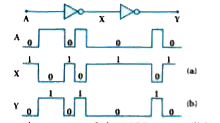In an unbiased p-n junction, holes diffuse from the p-region to n-region because Solution in Gujrati
free electrons in the n-region attract them
they move across the junction by the potential difference.
hole concentration in p-region is more a compared to n-region.
All the above.
The correct Answer is:C
hole concentration in p-region is more a compared to n-region.
In the unbiased p-n junction, holes diffuse from the p-region to n-region because holes concentration in the p-region is high as compared to n-region.
Topper's Solved these Questions
- BOOK - KUMAR PRAKASHANCHAPTER - SEMICONDUCTOR ELECTRONICS : MATERIALS, DEVICES AND SIMPLE CIRCUITS EXERCISE - Section-B : Numericals (Numerical From .DARPAN. Based On Textbook)14videos
SEMICONDUCTOR ELECTRONICS : MATERIALS, DEVICES AND SIMPLE CIRCUITS
- BOOK - KUMAR PRAKASHANCHAPTER - SEMICONDUCTOR ELECTRONICS : MATERIALS, DEVICES AND SIMPLE CIRCUITS EXERCISE - Section-C: NCERT Exemplar Solution (Multiple Choice Qustion (MCQs) )8videos
SEMICONDUCTOR ELECTRONICS : MATERIALS, DEVICES AND SIMPLE CIRCUITS
- BOOK - KUMAR PRAKASHANCHAPTER - SEMICONDUCTOR ELECTRONICS : MATERIALS, DEVICES AND SIMPLE CIRCUITS EXERCISE - Section-B : Numericals (Numerical From Textual illustrations)16videos
SEMICONDUCTOR ELECTRONICS : MATERIALS, DEVICES AND SIMPLE CIRCUITS
- BOOK - KUMAR PRAKASHANCHAPTER - SAMPLE QUESTION PAPER EXERCISE - PART-B SECTION-C5videos
SAMPLE QUESTION PAPER
- BOOK - KUMAR PRAKASHANCHAPTER - WAVE OPTICSEXERCISE - SECTION-D (MULTIPLCE CHOICE QUESTIONS (MCQS)) (MCQS FROM DARPAN BASED ON TEXTBOOK)239videos
WAVE OPTICS
Similar Questions
A logic circuit is shown in the diagram. Draw the output signal at the point X and Y for the input signal shown in the figure at point A.
 01:41View Solution
01:41View SolutionThe conductivity of a semiconductor increases with increase in temperature because
02:29View SolutionC, Si and Ge have same lattice structure. Why is C insulator while Si and Ge intrinsic semiconductors?
View SolutionTwo charges –q and +q are located at points (0, 0, –a) and (0, 0, a), respectively.
(a) What is the electrostatic potential at the points (0, 0, z) and (x, y, 0) ?
(b) Obtain the dependence of potential on the distance r of a point from the origin when r/a>>1 .
(c) How much work is done in moving a small test charge from the point (5,0,0) to (–7,0,0) along the x-axis? Does the answer change if the path of the test charge between the same points is not along the x-axis?02:31View SolutionAccording to particle theory of light what is the velocity of light in a dense medium, compared to that in rare medium ?
02:21View SolutionIn an unbiased p-n junction electrons diffuse from n-region to p-region because :-
View SolutionIn an unbiased p-n junction holes diffuse from the p-region to the n-region because
03:14View SolutionIn p-n junction diode, holes diffuse from p-region to n-region because
View SolutionIn an unbiased p-n junction electrons diffuse from n region to p region because
01:38View SolutionIn an unbiased p-n junction , holes diffuse from the p-region to n- region because
View Solution4 In an unbiased p-n junction, holes diffuse from the p-region to n-region because
01:38View Solution4 In an unbiased p-n junction, holes diffuse from the p-region to n-region because
02:29View SolutionIn an unbiased p-n junction, holes diffuse from the p-region to n-region because
02:04View Solution4 In an unbiased p-n junction, holes diffuse from the p-region to n-region because
02:15View SolutionIn an unbiased p-n junction, holes diffuse from the p-region to n-region because
02:18View Solution

